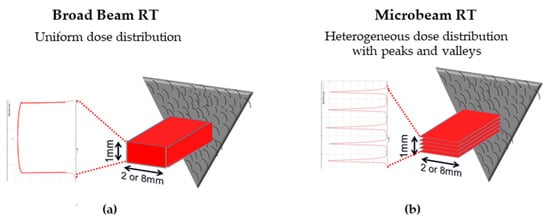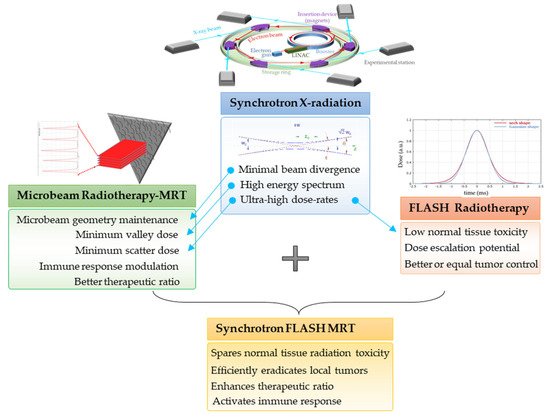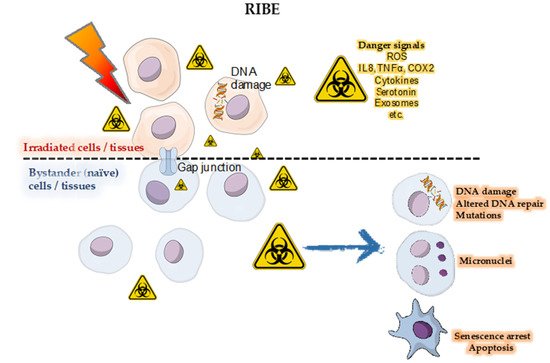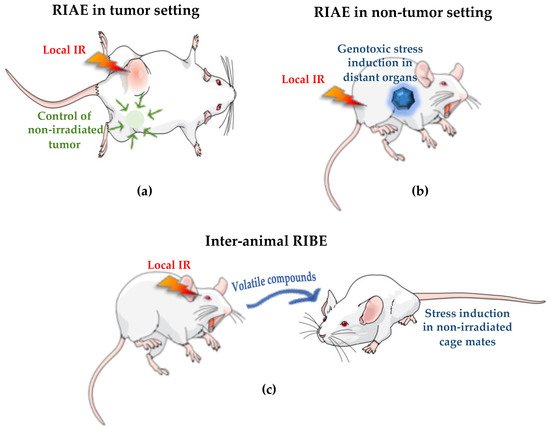The Australian Synchrotron (AS) and the European Synchrotron Radiation Facility (ESRF) are best configured for a wide range of biomedical research involving animals and future cancer patients. Due to ultra-high dose rates, treatment doses can be delivered within milliseconds, abiding by FLASH radiotherapy principles. In addition, a homogeneous radiation field can be spatially fractionated into a geometric pattern called microbeam radiotherapy (MRT); a coplanar array of thin beams of microscopic dimensions. Both are clinically promising radiotherapy modalities because they trigger a cascade of biological effects that improve tumor control, while increasing normal tissue tolerance compared to conventional radiation. Synchrotrons can deliver high doses to a very small volume with low beam divergence, thus facilitating the study of non-targeted effects of these novel radiation modalities in both in-vitro and in-vivo models. Non-targeted radiation effects studied at the AS and ESRF include monitoring cell–cell communication after partial irradiation of a cell population (radiation-induced bystander effect, RIBE), the response of tissues outside the irradiated field (radiation-induced abscopal effect, RIAE), and the influence of irradiated animals on non-irradiated ones in close proximity (inter-animal RIBE).
1. Introduction
One of the greatest advances in the field of radiation research is the evolution of the use of synchrotron X-rays in a variety of medical and biological applications, extending to imaging, diagnostics, and radiotherapy (RT). Typical photon energies in synchrotron beams dedicated to biomedical applications range from approximately 10 to 150 keV. Currently, many synchrotron facilities operate with an electron beam energy greater than or equal to 2.4 GeV and high electron-beam currents are achievable in the accelerator ring of third- and fourth-generation synchrotrons, which include the Australian Synchrotron (AS) in Melbourne, the National Synchrotron Light Source (NSLS) in Brookhaven, USA and the European Synchrotron Radiation Facility (ESRF) in Grenoble, France, [
1,
2,
3].
The ESRF shares a physical site, called the European Photon and Neutron Science Campus, with the neutron source Institut Laue-Langevin and the European Molecular Biology Laboratory. The AS is a major research facility located in Clayton, a technology and innovation hub of southeast Melbourne. The AS belongs to the Australian Nuclear Science and Technology Organization (ANSTO), which is a statutory body of the Australian government, formed in 1987 to replace the Australian Atomic Energy Commission. Currently, AS and ESRF facilities are best configured for a wide range of biomedical research studies, including animals and potentially human cancer patients in the future.
2. Characteristics of Synchrotron X-rays at AS and ESRF
The key characteristics of synchrotron X-rays relevant for radiobiology include:
-
The high brightness, or brilliance, which describes synchrotron radiation power. Brilliance measures the source quality and implicates the number of photons produced per second. The higher the brilliance value, the stronger the emitted beam.
-
The low divergence of the synchrotron beam enables the irradiation of the target with collimated parallel microbeams, in contrast to conventional RT. The low divergence results from the fact that the target is several meters away from the permanent magnet wiggler which generates the X-ray beam. At the AS, the distance between the wiggler and the target is about 32 m, while at the ESRF it is 40 m.
-
The beam current, which is the basic quantity of the beam. In this regard, the ESRF’s characteristics are superior to those of the AS. The ESRF has a significantly longer periphery of 844 m, while the AS has 200 m. The brilliance values are 8 × 10
20 and 4.6 × 10
18 photons/(s × 0.1% bandwidth × mrad
2) for the ESRF and AS, respectively [
7]. Both have a beam current of 200 mA; however, the maximum electron energy is 6 GeV for ESRF and 3 GeV for AS.
-
The intense flux (dose rate) of photons allows samples to be irradiated very quickly in the range of seconds and milliseconds. Dose rates in the AS range from 30–1000 Gy/s, while at the ESRF can be up to 16,000 Gy/s.
-
The energy of the synchrotron beam is in the KeV range, which has the advantage of allowing for low secondary electron (Compton) scattering. The energy range at both the AS and ESRF is “tunable”, meaning, the energy spectrum can be filtered to remove low energy photons and use a poly energetic X-ray beam typically between 30 and 120 KeV.
3. Synchrotron-Generated Novel RT Modalities
3.1. Microbeam Radiation Therapy (MRT)
Biomedical beamlines at synchrotrons can generate both uniform (broad beam, BB) radiation fields as well as spatially fractionated fields (
Figure 1). The radiation field can be spatially fractionated by adding a multislit collimator to the beam path. This generates an array of planar X-ray microbeams, typically only tens of μm thick, separated by gaps of a few hundred μm [
8]. This array of microbeams is known as MRT and is used to target tumors in animal models. MRT shows significant promise for increased tumor control and reduced normal tissue damage compared to conventional RT. Synchrotrons can generate such high dose rate X-ray microbeams with physical properties superior to conventional sources [
9].
Biomedical beamlines at synchrotrons can generate both uniform (broad beam, BB) radiation fields as well as spatially fractionated fields (
Figure 1). The radiation field can be spatially fractionated by adding a multislit collimator to the beam path. This generates an array of planar X-ray microbeams, typically only tens of μm thick, separated by gaps of a few hundred μm [
8]. This array of microbeams is known as MRT and is used to target tumors in animal models. MRT shows significant promise for increased tumor control and reduced normal tissue damage compared to conventional RT. Synchrotrons can generate such high dose rate X-ray microbeams with physical properties superior to conventional sources [
9].
Figure 1. Synchrotron can generate both broad beams and microbeams. (a) Broad beam synchrotron RT is a type of conventional RT which uses spatially uniform dose distribution. (b) MRT has a heterogeneous dose distribution with ablative peak and low valley doses. Typical beam dimensions used in the AS experiments are described below.
The MRT collimator normally produces planar microbeams of 25 or 50 μm thick spaced by 200 or 400 μm center-to-center in the horizontal dimension. In the vertical dimension, the microbeam array is just a few mm high (between 0.3 to 1.5 mm). However, this can be extended by using the goniometer stage to scan the sample vertically through the beam, and thus extending the microbeam array several cm. The multislit collimator then generates a heterogenous dose distribution, where hundreds of Gy are delivered directly by the microbeams (“peak doses”) with regions between them receiving low-dose scatter irradiation (“valley dose”). However, this heterogeneous dose distribution depends on factors such as the energy spectra inherent to the synchrotron facility:
-
The main clinical research focus at the IMBL, AS, are RT and imaging. Imaging can be performed in an energy range of 15–150 KeV, while radiotherapy can be performed in an energy range of 30–120 KeV and with dose rates close to 1000 Gy/s [
10]. The radiation source of MRT is a wiggler with a peak magnetic field of 4.2 T [
11]. Starting from a storage ring current of 200 mA, a standard MRT spectral configuration can be delivered in 300 Gy/s by setting the wiggler to 3 T, which produces a spectrum with an average energy of 94 KeV and a peak energy of 87 KeV. Another MRT configuration can deliver 991.7 Gy/s by setting the wiggler to 4 T, with similar spectra as above (93 KeV on average) [
12].
-
The ESRF’s beamline ID17 is also intended for medical imaging and RT studies. The radiation used for MRT comes from a wiggler of 1.5 m in length and a magnetic field of 1.6 T at a gap of 24.8 mm. The X-ray beam produced by the wiggler then continues for 37 m until it is attenuated to produce one of three different spectral configurations: (i) the standard MRT configuration used for rodent experiments for many years has an average energy of 104.2 KeV and a peak energy of 87.7 keV, (ii) the preclinical MRT configuration developed for veterinary trials and has a mean energy of 119 KeV and a peak energy of 102.1 KeV, and/or (iii) the clinical MRT configuration for future clinical applications with a mean energy of 122.8 KeV and a peak energy of 108.2 KeV [
3,
13].
Synchrotron radiation is required for MRT because: (i) the minimal beam divergence maintains the microbeam geometry at the microscopic level, (ii) the X-ray energy spectrum of 80–150 keV minimizes the range of secondary electrons that make an important contribution to the valley dose, and (iii) the ultra-high dose rates avoid beam smearing due to the cardiovascular movement [
14]. The use of ultra-high dose rates has another advantage, namely the reduced radiation toxicity of normal tissue due to the rapid irradiation. This phenomenon is called the FLASH effect and is considered one of the most promising recent advances in radiation oncology.
3.2. Ultra-High Dose Rate Radiotherapy (FLASH-RT)
FLASH-RT delivers large single doses of radiation (10–30 Gy) with ultra-high dose rates, in less than 500 ms [
15]. The whole idea lies on preliminary theoretical and experimental results showing very low normal tissue toxicity enabling dose escalation and thus enhanced tumor control. Within this context, FLASH-RT is considered for electrons and protons, but also photons [
16]. The normal tissue sparing effect, the “FLASH effect”, prevents lung and brain toxicity, based on studies in several cellular or animal models [
17]. Recently, it was confirmed that FLASH-RT spared normal rat brain from radiation-induced cognitive impairment when the overall irradiation time was less than 200 ms [
15]. The FLASH effect has been shown to occur in pig’s skin and squamous cell carcinoma (SCC)-bearing cat patients irradiated within a phase I veterinary clinical trial [
18,
19], indicating the treatment potential for human patients. High radiotolerance of normal tissues was observed using X-ray micro or broad beams delivered in a FLASH mode [
20].
3.3. MRT Delivered in a FLASH Mode
Micrometer collimation allows for the application of hecto-Gy doses and is the basis for the FLASH-mode MRT [
22] (
Figure 2). A highly heterogeneous pattern of high and low radiation doses is delivered simultaneously in just a few milliseconds thanks to the ultra-high dose rates of the synchrotron facilities (up to 16 kGy/s). Compared to conventional RT, this MRT dose delivery pattern has been proven to (i) spare various normal tissues from radiation-related toxicity [
6], and (ii) efficiently eradicate local tumors [
23] (
Figure 3 and
Figure 4).
Figure 2. Synchrotron X-ray radiation properties are essential for both MRT and FLASH RT. Synchrotron MRT in FLASH mode is the combinatorial result of MRT and FLASH RT, whose properties dictate its therapeutic potential.
Figure 3. Radiation-induced bystander effect (RIBE). Directly irradiated cells produce danger signals inducing DNA damage and cell death in adjacent, non-irradiated cells. The latter are called bystander or naïve cells.
Figure 4. Non-targeted effects in animals that can be generated at synchrotron facilities. RIAE within the same organism in tumor (a) and non-tumor settings (b) display different systemic effects mediated by the immune system. RIAE can be both beneficial (a) or genotoxic (b). (c) Detrimental or beneficial non-targeted effects mediated by volatile factors can occur in another bystander organism(s) sharing an environment with irradiated animals.
Studies of synchrotron MRT in animal models indicated that tumors can be ablated by MRT at radiation levels that spare normal tissues [
8,
24,
25,
26]. Thus, the therapeutic index for MRT is greater than conventional RT, and it is quite conceivable that MRT may become a major mode of cancer RT in the future.
4. Radiation-Induced Bystander and Abscopal Effects
4.1. Studies of RIBE and RIAE and Their Mediators
Cancer RT is based on the dogma that radiation kills targeted cells. This dogma is challenged by the radiation-induced bystander effect (RIBE), in which unirradiated (naïve) neighboring cells can also be damaged after receiving signals from irradiated populations, whether through direct cell-to-cell contact or exposure to conditioned medium (
Figure 3) [
39,
40,
41,
42]. RIBE is now a well-established consequence of ionizing radiation and manifests as increased genomic abnormalities and loss of viability of ‘naïve’ cells. Nagasawa and Little [
43] published the first modern report on RIBE. Their data showed that alpha particles directed at 1% of a given cell group induced sister chromatid exchanges in 30% of that population. The authors supported their findings with statistical data showing that the proportion of cells damaged by a single alpha particle was less than the number of cells that exhibited sister chromatid exchanges. Later it was discovered that the targeted cells release damage-inducing substances into the medium, and medium conditioned by irradiated cultures was shown to induce various types of genotoxic events in unirradiated cultures [
40].
Although RIBE are usually considered detrimental to the cell, there are also reports of protective bystander effects in vitro, such as (i) bystander signaling leading to a reduction in neoplastic transformation [
73] and (ii) evidence that bystander effects trigger adaptive responses [
74,
75]. In fact, for decades, radiation oncologists have reported reactions in normal, unirradiated tissues after RT. These “out-of-field”, or abscopal effects have been described as “an action at a distance from the irradiated volume but within the same organism” [
76]. The discovery of the RIBE has prompted the description of radiation-induced abscopal effects (RIAE) as distant in vivo bystander effects, and their further investigation. Several studies reported in vivo RIAE in animal models. Using strategies that involve partial head or body 1 Gy X-ray irradiation, profound genetic and epigenetic changes were identified in shielded organs, such as skin and spleen [
77,
78]. Others reported DSBs, apoptosis, and tumor induction in shielded cerebellum of 3 Gy X-ray-irradiated radiosensitive Ptch1 heterozygous mice [
79]. Strikingly, the results of the in vivo non-targeted effects can be transmitted to future generations. While genomic instability was known to be elevated in offspring of parents whose germ cells were directly irradiated prior to conception as part of a medical procedure [
80], male rats given cranial irradiation (20 Gy applied as two doses of 10 Gy on two consequent days) had an accumulation of unrepaired DNA damage in their sperm cells [
81]. This effect was manifested as epigenetic dysregulation in the unexposed progeny conceived after paternal exposure. RIBE and RIAE are potential contributors to the well-documented clinical phenomenon of secondary cancers, a major concern in cancer RT, affecting more than 1% of patients [
40,
82].
4.2. First RIBE Studies at Synchrotrons
Bystander effects are important in synchrotron radiation because tissues exposed to valley doses also receive the signals emitted by cells in the peak dose regions and vice versa. Research on the relevance of these bystander effects in synchrotron RT has a traceable history of no more than 14 years. The first study to suggest that bystander effects play an important role in synchrotron MRT was published by Dilmanian et al. [
24]. In their experiments, the team irradiated bovine aortic endothelial cells and rat spinal cord with MRT. The results showed that the elimination of apoptotic cells and repair processes were faster than expected. This finding suggests that “beneficial” bystander factors are involved in tissue repair by promoting proliferation, migration, and differentiation of progenitor cells in the spinal cord. However, there are previous studies showing an increase in cell proliferation [
92] and radiation-induced changes in the immune response of local immune cells and tumors [
93], but these have not been associated with bystander effects.
5. Conclusions
In conclusion, extensive data have accumulated over the years on studies of RIBE and RIAE generated by synchrotron sources. While the results are largely consistent with those obtained after irradiation by conventional sources, there are several areas that should be investigated further. First, it is important to decouple the role of peak doses, valley doses, and transition zone doses in the induction of signaling molecules. Perhaps next-generation sequencing focusing on spatial transcriptomic analysis could shed more light on these mechanisms. Second, synchrotron facilities are capable of delivering MRT at ultra-high dose rates, but the studies reviewed here largely do not consider FLASH-RT; only generated non-targeted effects. This is a limitation of our review, but we believe that this vacuum is rooted in the fact that the FLASH effects have only recently been rediscovered. Therefore, it would be of great importance to re-evaluate some results with special reference to dose rate. This reevaluation could shed more light on interesting findings such as the protective bystander proteome or the involvement of the immune system in RIAE.
This entry is adapted from the peer-reviewed paper 10.3390/app12042079




